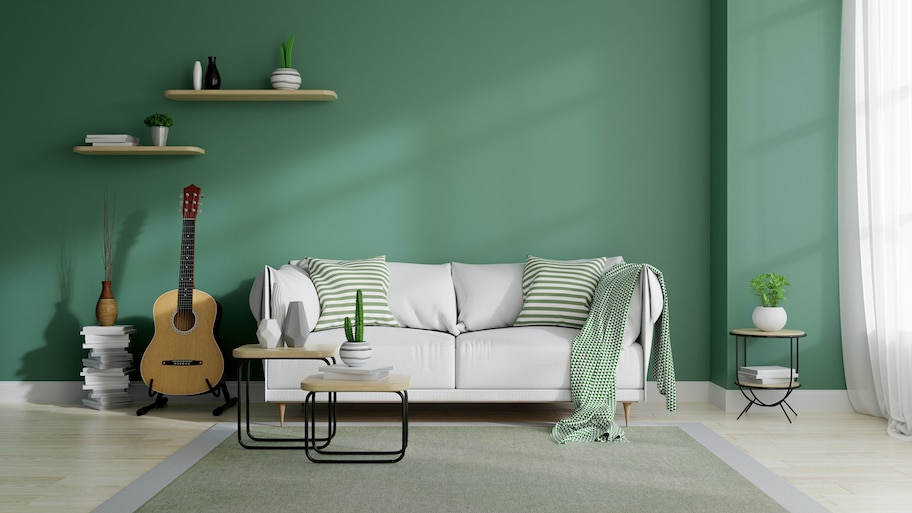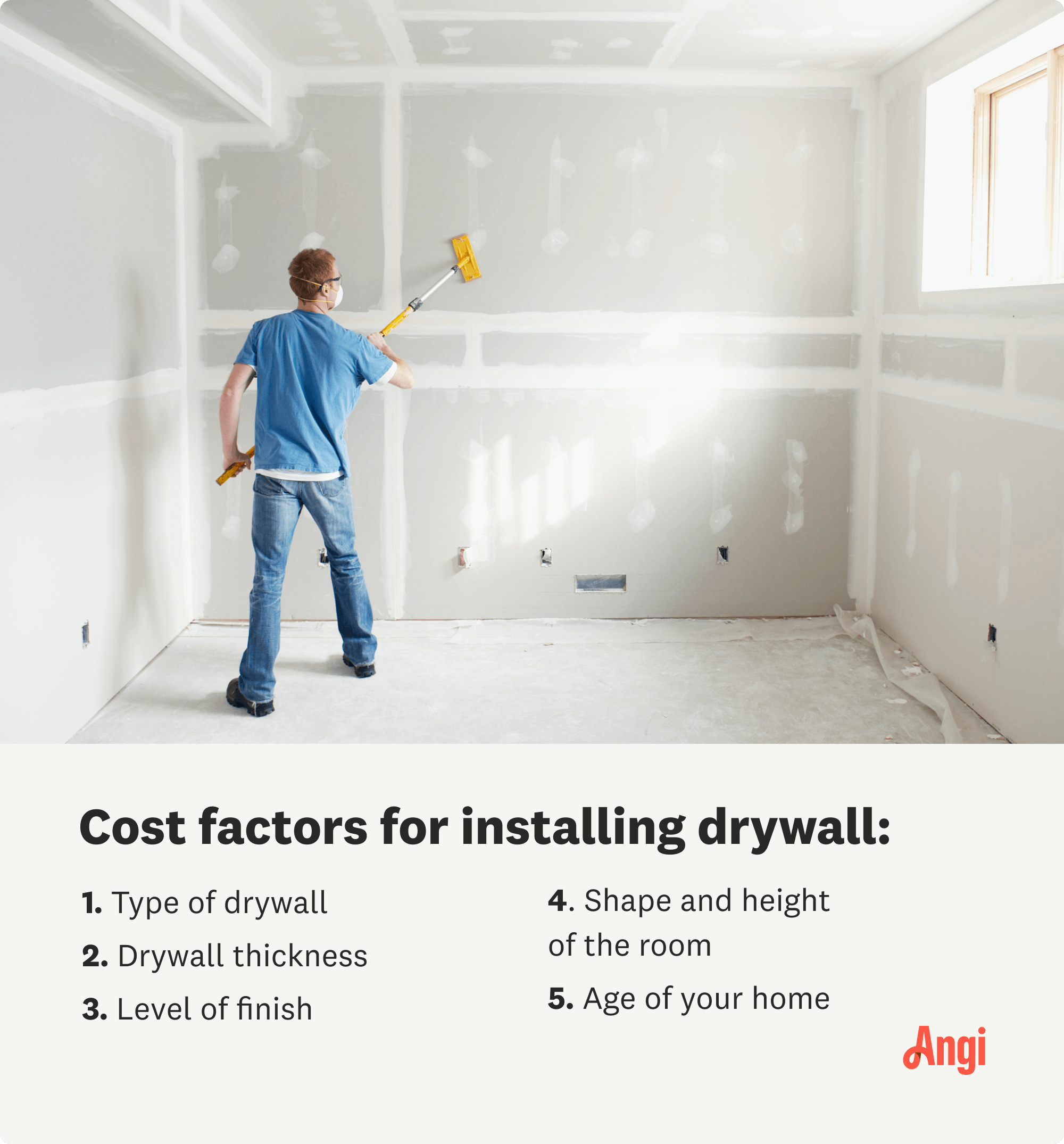How Much Does Drywall Installation Cost? [2024 Data]
Normal range: $988 - $3,200
The average drywall installation cost is $2,091, with a typical range of $988 to $3,200, but drywall type, thickness, and finish will affect the price.


The average cost to install drywall includes materials and labor and runs between $1.50 and $3 per square foot. That equates to about $60 to $90 per drywall panel. The drywall thickness, the type of drywall, and other factors can influence what you'll pay. Total drywall installation costs can range from $988 to $3,200 for the whole project, with an average price of $2,091. Learn all the cost factors and what to consider to get an accurate estimate for your drywall installation job.
- Average
- $2,091
- Low end
- $400
- high end
- $6,500
What Factors Impact the Cost of Drywall Installation?
The type, thickness, and finish of the drywall and the age of your home can all affect the cost of installing drywall.

Type of Drywall
Standard drywall is the most affordable option, but more expensive types may be worth the additional investment in some scenarios.
Moisture-resistant panels: Useful for humid rooms, like the bathroom or kitchen.
Mold-resistant panels: If the room you’re drywalling is susceptible to high levels of moisture, then opting for a mold-resistant material could be worth it. They’re more expensive than standard moisture-resistant panels, though, and still won't cope with saturated, flooded conditions.
Fire-resistant panels: Using non-combustible fibers of different ratings, these are common in commercial settings. Building code sometimes requires these in a garage if it shares a wall or ceiling with the main home, or in a boiler room for safety purposes.
Soundproof panels: Ideal for a music room, a baby’s room if you want to dampen external ambient noise, or even a teen’s bedroom if they enjoy listening to loud music. These are also popular for master bedrooms to enhance privacy.
Eco-friendly panels: Drywall panels made from recycled materials are available, but sustainable materials typically cost a bit more.
Drywall Thickness
Drywall thickness can sway your total price. If you’re on a minimal budget, you might want to opt for the thinnest quarter-inch panels. Three-eighths-inch and half-inch are the most common varieties. Soundproof and fire-resistant panels are usually five-eighths-inch thick. Drywall is sometimes available in 3/4" thicknesses for added soundproofing.
| Drywall Thickness (Inches) | Ideal Use Case | Average Cost Per Panel |
|---|---|---|
| 1/4 | Curved areas or patches | $15 |
| 3/8 | Patches or repairs | $16 |
| 1/2 | Standard walls | $20 |
| 5/8 | Standard ceilings, fire-proofing | $21 |
| 3/4 | Sound-proofing, fire-proofing | $23 |
Level of Finish
Your drywall installation costs will vary depending on what level of drywall finish you agree upon with your contractor.
| Level | Description | Average Cost (per Sq. Ft.) |
|---|---|---|
| 0 | Contractor hangs the drywall and no more | $0.80–$1 |
| 1 | Drywall has the seams sealed with tape and then covered with mud | $1–$2 |
| 2 | Has one coat of joint compound, typically to allow tiling on top | $1.25–$2.50 |
| 3 | Has two coats of joint compound for a smoother finish | $1.50–$3 |
| 4 | If you plan to use matte paint, pros recommend the application of three coats of joint compound | $1.65–$3.15 |
| 5 | A very high-quality finish which is the best option for enamel and gloss paint application. This includes three coats of joint compound and a full skim coat for a super-smooth appearance | $2–$3.50 |
Texture
Adding texture to drywall enhances a room's aesthetic appeal and helps hide imperfections. Depending on the type of texture, the average cost to texture drywall ranges from $1 to $1.95 per square foot.
Some common texture types include:
Popcorn: A bumpy texture created by spraying drywall mud and polystyrene onto the ceiling
Orange Peel: A subtle, dimpled texture resembling an orange’s skin
Knockdown: A rustic texture that requires the added step of flattening peaks
Skip Trowel: A rough, uneven texture applied using a trowel
Sand Swirl: A decorative pattern created by applying a mixture of sand and drywall
Venetian Plaster: A luxurious, polished finish created by applying multiple layers of tinted plaster and then burnishing it
Age of Your Home
If you have a home that’s over 40 years old, there’s a chance that asbestos or lead paint is present. Mold problems are also a more common issue in older homes. If you have concerns about these issues, it’s sensible to have a home inspection before any work hanging new drywall begins. If any of these are present, you could end up paying anything from $1,000 to $3,000 or more for lead, mold, or asbestos removal near you.
Shape and Height of the Room
If your room is higher than average, has rounded corners, complex overhanging cornices, or arched doors, this could mean additional work cutting the drywall for your contractor. All of these will increase the labor cost of your drywall installation project.
Removal of Older Wall Material
Before installing new drywall, a pro may need to remove existing wall materials. To remove wood paneling, you’ll pay $0.50 to $1 per square foot. Replacing plaster walls is more challenging and costs $1.50 to $3 per square foot.
Drywall Installer Cost
Labor accounts for about 70% of the cost of installing drywall. Hiring a local drywall installer will cost $1 to $2.10 per square foot, totaling $690 to $2,200 on average.
Complex installations, such as those with curved walls, high ceilings, or intricate architectural details, require more time and expertise, increasing labor costs. You can also expect to pay more or less for labor depending on the type of finish — a basic finish with taping and mudding costs less than a smooth, high-end finish.
The most common tasks a drywall installer performs are:
Hanging drywall sheets
Taping and mudding
Sanding
Priming
Finishing
Cost to Install Drywall by Room Size
Whether you’re working on a small bathroom or a spacious living room, having an estimate of costs based on room size can help you plan your budget more effectively. Installing drywall in a small bathroom of around 100 square feet will cost $400 to $650, while for a large living room, it can range from $1,500 to $3,000.
Here’s a chart that gives the average costs for installing drywall in different common room sizes:
| Room Size (in Sq. Ft.) | Average Cost |
|---|---|
| 100 (Small Bathroom) | $400–$650 |
| 200 (Small Bedroom) | $550–$1,000 |
| 300 (Large Bedroom) | $900–$1,500 |
| 400 (Small Living Room) | $1,100–$2,200 |
| 500 (Large Living Room) | $1,400–$2,800 |
| 600 (Large Space) | $1,700–$3,100 |
Cost to Install Drywall by Location
The cost of home renovation projects and repairs can vary depending on where you live. If you want a rough idea of how much it would cost to install drywall where you are, the averages outlined below illustrate how prices can differ across the U.S.:
| State | Cost |
|---|---|
| Alabama | $1,600 |
| Atlanta | $2,000 |
| California | $1,800 |
| Mississippi | $2,700 |
| Florida | $1,700 |
| New York | $2,300 |
| North Carolina | $1,600 |
| Ohio | $1,400 |
| Pennsylvania | $2,300 |
| Texas | $1,600 |
How Much Drywall Can I Get on My Budget?
If you have a limited budget, you might need to make some compromises in your drywall installation. Take a look at what you can expect at various price points.
$500
If you have had a small utility room built onto your home and just want to cover up the exposed studs and rafters, you could request a basic drywall installation. The contractor would hang the drywall, but for this price, the job likely wouldn’t include taping, mud, or finishing.
$1,500
A typical living room is around 200 square feet. Providing you aren’t looking for the most luxury finish or the most expensive type of drywall panel, it isn’t unreasonable to budget around $1,500 for this type of job, including installation.
$5,000
For drywall installation in a large basement, you could expect to pay a local basement remodeling pro around $5,000 for a 1,000-square-foot space, provided you’re not looking for specialized panels.
$10,000
If your space is over 1,000 square feet and you’re looking to use moisture-resistant panels and have a high-quality finish, it could cost as much as $10,000 to install drywall.
DIY vs. Hiring a Pro to Install Drywall
You can save a lot of money by installing drywall yourself—usually around an average of $1,400 per project, or between $40 and $70 per panel, depending on the level of finish you want. While the cost savings of DIY drywall installation are significant, most people choose to hire a professional, regardless of their level of experience.
But how hard is it to lay drywall, anyway? Hanging drywall is a deceptively challenging process because it’s easy in theory, but consider studs and rafters that aren’t plumb and the small, sometimes intricate cuts required around corners and electrical boxes, and the job can be massively frustrating. Plus, finishing drywall is a time-consuming process, and even minor mistakes will show for years to come.
While professional drywall installation costs can reach into the thousands, it’s usually worth it to have a pro carry out the work for a high-quality finished product. Hiring a local drywall installer will save you time, money, and frustration, and they’re likely to leave you with a better result in the end.
How to Save on Drywall Installation Costs
While installing the drywall yourself can save you money, it’s often better to have a pro do it to avoid further issues down the line and ensure a high-quality finish. But you can take these steps to save on the costs without compromising quality:
Do Prep Work Yourself: Clear the room, remove old wall coverings, and make minor repairs yourself to reduce the time and labor of your pro.
Opt for Standard Sizes: Use standard-sized drywall sheets, which are cheaper and easier to install.
Choose a Lower Finish Level: If high-end finishes aren’t necessary, opting for a Level 3 or 4 finish instead of a Level 5 finish can greatly reduce labor costs.
Schedule During Off-Peak Times: Installers may offer lower rates during their slow seasons, which tend to be in the winter.
Negotiate Waste Removal: Handle the disposal of old materials yourself or rent a dumpster, as installers may charge extra for waste removal.
How Angi Gets Its Cost Data
Home is the most important place on earth, which is why Angi has helped more than 150 million homeowners transform their houses into homes they adore. To help homeowners with their next project, Angi provides readers with the most accurate cost data and upholds strict editorial standards. We’ve surveyed over 10,000 real Angi customers about their project costs to develop the pricing data you see, so you can make the best decisions for you and your home. We pair this data with research from reputable sources, including the U.S. Bureau of Labor Statistics, academic journals, market studies, and interviews with industry experts—all to ensure our prices reflect real-world projects.
Want to help us improve our cost data? Send us a recent project quote to [email protected]. Quotes and personal information will not be shared publicly.
Frequently Asked Questions
The average life span for drywall is between 40 and 60 years, although panels can last significantly longer in many cases if it’s well-maintained. Of course, many things can reduce the life span of your drywall, including fire, smoke damage, water, moisture, and physical damage, like dents and holes. Thankfully, you’re likely to get around 50 years of value out of professionally-installed drywall, making the $2,000 you’ll spend on the job well worth it in the long run.
In most cases, no, you won’t need a permit to replace drywall. If you’re changing the floorplan of your home by adding or removing walls during the drywall project, then you might need a permit, but replacement or repairs usually doesn’t require a permit. Your drywall professional should be able to confirm whether or not a permit is required for your project. If it is, it’s likely to add between $50 and $150 to your total cost. Keep in mind that you will need permits if you plan to install new electrical wiring or plumbing lines behind your new drywall.
Drywall installation is considerably faster and more affordable than plastering. Because plastering involves applying a wet material, it’s more time-consuming, takes longer to dry, and is more prone to cracking. It doesn’t tend to be as insulative either. If you need resurfacing work done on the walls, it's not unusual for the cost of plastering to hit $10 per square foot, which is much higher than the drywall installation costs of $1.50 to $3 per square foot.
If you’re looking for good soundproofing and want a high-end look in a historic home, though, plastering may be the better option.
Including wall area, ceilings, and extra for waste and cuts, you’d need about 6,000 to 8,000 square feet of drywall for a 2,000-square-foot house. The actual amount can vary based on the specific design and layout of your home, such as the number of rooms and ceiling height.

